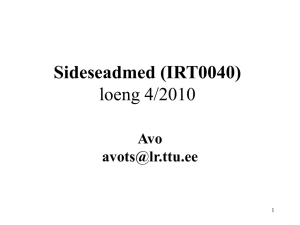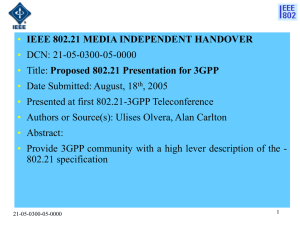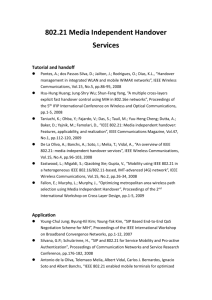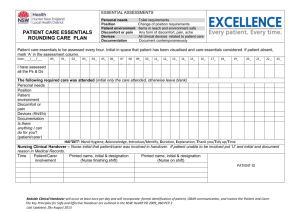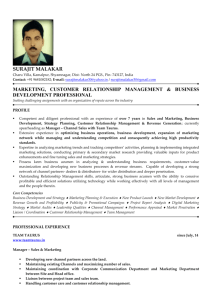21-05-0300-06-0000-InterDigital802_21Presentation
advertisement
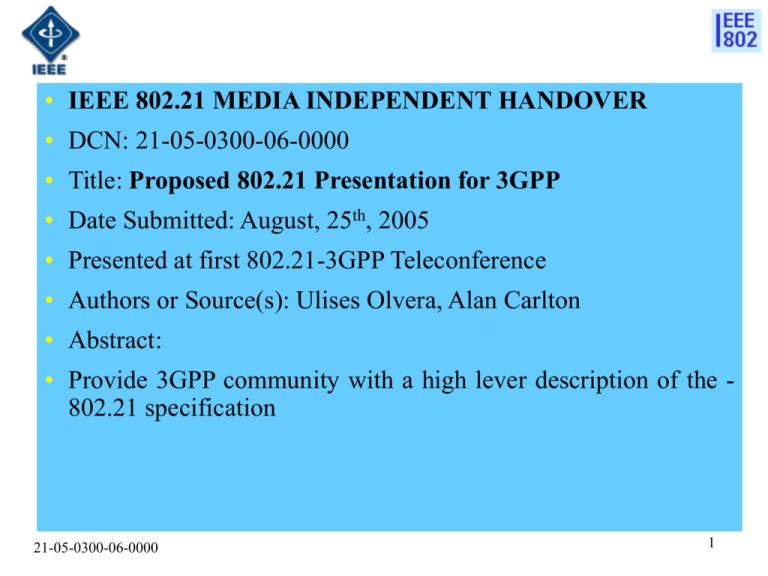
• IEEE 802.21 MEDIA INDEPENDENT HANDOVER • DCN: 21-05-0300-06-0000 • Title: Proposed 802.21 Presentation for 3GPP • Date Submitted: August, 25th, 2005 • Presented at first 802.21-3GPP Teleconference • Authors or Source(s): Ulises Olvera, Alan Carlton • Abstract: • Provide 3GPP community with a high lever description of the 802.21 specification 21-05-0300-06-0000 1 IEEE 802.21 presentation release statements • This document has been prepared to assist the IEEE 802.21 Working Group. It is offered as a basis for discussion and is not binding on the contributing • • individual(s) or organization(s). The material in this document is subject to change in form and content after further study. The contributor(s) reserve(s) the right to add, amend or withdraw material contained herein. The contributor grants a free, irrevocable license to the IEEE to incorporate material contained in this contribution, and any modifications thereof, in the creation of an IEEE Standards publication; to copyright in the IEEE’s name any IEEE Standards publication even though it may include portions of this contribution; and at the IEEE’s sole discretion to permit others to reproduce in whole or in part the resulting IEEE Standards publication. The contributor also acknowledges and accepts that this contribution may be made public by IEEE 802.21. The contributor is familiar with IEEE patent policy, as outlined in Section 6.3 of the IEEE-SA Standards Board Operations Manual <http://standards.ieee.org/guides/opman/sect6.html#6.3> and in Understanding Patent Issues During IEEE Standards Development http://standards.ieee.org/board/pat/guide.html> 21-05-0300-06-0000 2 Why 802.21? 3GPP Interworkging Scenario 4 requires to: •Enable automatic transitions between a WLAN and a 3GPP system when entering or leaving region of system coverage without manual user intervention •Enable user activation of automatic transitions •Enable on demand network availability queries •Enable automatic network availability notifications 21-05-0300-06-0000 3 Why 802.21? 3GPP Interworkging Scenario 5 requires to: •Enable handover between a WLAN and a 3GPP system and between a 3GPP and a WLAN in a way that is imperceptible to the user. Change of service shall not be greater than that what occurs during an intra 3GPP handover 21-05-0300-06-0000 4 Why 802.21? 802.21 Principles Dos: •802.21 specifies procedures that aid in the handover decision making, providing ling layer state information to MIH users. Enabling quicker change of service across heterogeneous networks •802.21 specifies procedures that aid in the provisioning of network information and the basic content of the this information. Enabling network availability notifications •802.21 specifies command procedures that allow service continuity across heterogeneous networks. Enabling imperceptible intertechnology handovers 802.21 Principles Don’ts •802.21 neither controls handover selection nor defines handover policies •802.21 neither controls network detection nor specifies network selection procedures nor network information provisioning 21-05-0300-06-0000 5 Goals •Aid 3GPP in the realization of Interworking Scenario 4 and 5 (ref.TR 22.934) •Work actively within relevant standard bodies in order to introduce applicable 802.21 requirements •Update relevant 3GPP groups with latest development in 802.21 standards 21-05-0300-06-0000 6 802.21 Model Terminal Side MIH User 1 … MIH User 2 MIH User n MIH Users MIH Commands MIH Events Information Media Independent Handover Function (MIH) Link Events Information Link Commands 3GPP UTRAN 802.3 802.11 3GPP GERAN 802.16 802 LINK LAYER CELLULAR LINK LAYER Link Layer 21-05-0300-06-0000 7 802.21 Model Network Side MIH Network Entity 1 MIH Network Entity 2 … MIH Network Entity n Ia’ 3GPP NAS/GMM MIH Network Entity MIH Commands MIH Events Information Media Independent Handover Function Link Events Link Commands 802.3 802.11 802 Network Element 21-05-0300-06-0000 Wn 3GPP AS/RR Information 802.16 Cellular Network Element 8 802.21 Model Client Station Higher Layer Transport (E.g., IP) IS/CS IS Higher Layer Transport (E.g.,IP) E/C/I Media Independent 802.21 Handover Handover User User IS/CS Media Independent Handover Network Entity (E.g., MIH Server Controller) 802 Network Ia’1 3GPP NAS/ GMM IS/CS/ES IS/CS over higher layer transport Wn2 Cellular Interface NAS/ GMM AS/ RR Cellular Network E/C/I Media Independent Handover Function E/C/I 802 Interface 3GPP AS/RR Media Independent Handover Function L3 L1 (E.g.,UTRAN, GERAN) MAC MAC PHY PHY LLC Events LLC Events Events L2 (E.g., RLC,RLP) Events Leyend: AS: Access Stratum E/C/I: Events/Commnads/Information Ia’1: Interface defined outside 802.21 ES/CS/IS: Event Service/Commnad Serive/Information Service MIH: Media Independent Handover NAS: Non-Access Stratum PPP: Point to Point Protocol Wn: Interface defined in 3GPP (TS 23234) LLC: Link Layer Control MAC: Medium Access Control PHY: Physical Layer Information Service over L2 Transport Remote MIH Events/MIH Commands over L2 Transport 21-05-0300-06-0000 9 Current 802.21 Scope Current Draft defines: • Media Independent Handover Principles and Design Assumptions •Supported Media Independent Services •Service Access Points and their Primitives •A Media Independent Handover Protocol 21-05-0300-06-0000 10 Design Assumptions Design Assumptions Dos: •802.21 cross-layer entity interacting with multiple layers. •802.21 Facilitates handover determination •802.21 Provides a technology-independent unified interface to upper layers and MIH users •802.21 facilitates both station initiated and network initiated handover determination. Both local and remote triggers are supported Design Assumptions Don’ts •802.21 does not modify existing handover principles •802.21 does not mandate handover determination based on 802.21 events. Events are informational in nature 21-05-0300-06-0000 11 Media Independent Services Media Independent Services Dos: •Mobility Management Entities access 802.21 services through well defined SAPs •More than one user can have access to 802.21 services in order to integrate multiple mobility protocols (E.g., Cellular –MIP) •802.21 services could be invoked to request operations on underlying resources Media Independent Services Don’ts •802.21 does not replaces existing mobility management function and protocols already in place 21-05-0300-06-0000 12 Media Independent Services (cont’d) Media Independent Services: •Event Service Dos • Local and Remote Events are supported • Events indicate changes in state behavior • Events indicate administrative state change • Events facilitate handover detection • Events are delivered according to 802.21 users preferences •Events Service Don’ts • Events do not propagate directly between heterogeneous stacks • Events do not enforce actions but rather suggest them 21-05-0300-06-0000 13 Media Independent Services (cont’d) Media Independent Services: •Information Service Dos • Provides heterogeneous network information within a particular geographical area • Information might be delivered through access technology broadcast/multicast procedures or through data base queries at a remote server • Information services might be dynamic or static •Information Service Don’ts • 802.21 does not define how the information server is accessed, but only what information is required • 802.21 does not specify how the information service might be implemented in a particular technology 21-05-0300-06-0000 14 Media Independent Services (cont’d) Media Independent Services: •Command Service Dos • Commands might flow from the 802.21 MIH user to 802.21 MIH and from 802.21 MIH to link layer entities • Commands might convey 802.21MIH user decision to switch from one access technology to the other. • Commands have both remote and local scope • Commands might optimized existing handover mechanisms •Command Service Don’ts • Commands do not flow directly from one access technology to other • Commands do not replace existing mobility management protocols and procedures. 15 21-05-0300-06-0000
